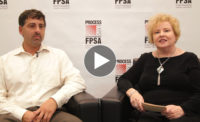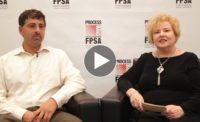![]()
Why, How, What and Where of Food Plant Audits
by Christopher Melchert
SFA Director of Regulatory and Technical Affairs
What should you look for in a food plant audit?
SFA Director of Regulatory and Technical Affairs
What should you look for in a food plant audit?
How is an audit conducted?
Why is a plant audit necessary?
Where do I get started?
The answers to these questions are key to understanding why an audit is important to a successful food protection program. Audits are basic elements in achieving improvements in a food manufacturing plant’s general operations, food safety record, and quality assurance programs. In other words, an audit is a check against the effectiveness of the system.
If done correctly, an audit will include examination of records, forms and performance criteria, in addition to assessing and reviewing the food safety system applications. Once the effectiveness of the food safety system is measured and the deficiencies are defined, corrective actions can be taken.
Audits are necessary. Regulatory agencies such as the U.S. Food and Drug Administration (FDA), the U.S. Department of Agriculture (USDA), the Environmental Protection Agency (EPA), and the Occupational Safety and Health Administration (OSHA) can require them. In addition, customers may require them. A final reason to conduct plant audits is that it makes sense to assure continuous improvements to food manufacturing plants.
An increasing number of regulations are being enacted that require site assessments, hazard analysis and workplace and equipment inspections. These new regulations increase the need to protect plant workers’ health and assure their safety. A company’s reputation and financial security can be protected by regular audits that take place at least once a year, depending upon government regulations, and/or customer requirements.
Audits are divided into several categories starting with the physical plant itself and including food protection and security. The following areas should be included in audits:
General plant facility conditions
Pest control management
Receiving, storage and shipments
Plant facility sanitation
Food safety program
Security.
General plant facility conditions
Pest control management
Receiving, storage and shipments
Plant facility sanitation
Food safety program
Security.
General plant facility conditions include assuring that the facility’s buildings, grounds and equipment are in proper condition. General conditions of the facility can have a direct impact on food safety and quality. Deficiencies in these conditions can indicate the lack of an effective preventive maintenance program.
The goal should be to have a safe and sanitary environment for the plant personnel and for finished product. A facility’s condition can have a direct impact on the company’s financial outcome.
Pest control management is related to facility conditions, assuring that the manufacturing environment operates in a safe and sanitary manner. The goal for pest control is to reduce the potential contamination of products from any pest activity.
An effective pest control program will strive to eliminate all pest activity and to monitor any evidence of a recurring infestation. A corrective action plan for tracking a pest control program over a period of time is necessary. This plan should identify any repetitive activity in the plant.
An audit of receiving, storing and shipments should check for proper record keeping. It is essential to have a system that tracks incoming and outgoing products, with an onsite inventory. Outgoing and incoming products need to be held in designated areas away from general storage. An effective record keeping system will help assure that products flow smoothly throughout a plant.
Plant facility sanitation audits should include verifying the record keeping system as well, such as Sanitation Standard Operating Procedures (SSOPs). SSOPs should cover both operational and pre-operational sanitation activities, including sanitation programs conducted in addition to the daily cleaning schedule. The SSOPs must be well-documented for both the plant and equipment, and must indicate that the programs and procedures are being performed.
Food safety programs are comprised of general food safety principles, along with Hazard Analysis Critical Control Point programs (HACCP) and Good Manufacturing Practices (GMPs). The purpose of these programs is to assure that the food manufactured in the plant is in compliance with all regulatory agencies laws and guidelines. Additionally, they should ensure that the integrity of the production will prevent potential contamination.
A food recall action plan also must be included in a food safety program. This plan needs to provide a method for tracing all products and their ingredients. This includes being able to identify what supplier’s lot an ingredient came from. The recall program must then be tested for effectiveness in the traceability and recovery of products. The effectiveness of the food safety program’s effectiveness is dependent on a thorough evaluation, and continuous improvements and documentation.
Plant security audits involve analyzing potential threats, and implementing security programs for both the physical facility and the food. A security threat survey of the facility, employees, transportation and food should be pre-formed to determine the vulnerability of the plant. Then corrective improvements should be made based on the results of the survey in order to protect the facility against the possibility of a threat.
Levels of Audits
Now that we have discussed the “what, why and where” of a food plant audit, the “how” can be conducted as first-, second- or third-party audits. The first-party audits are usually self audits where employees of the food manufacturing plant carry out an internal audit. The self or internal audit is useful to assess whether the food manufacturing plant meets regulatory requirements and to review the food safety program. It also provides the opportunity to prepare for and make improvements prior to the next two steps.
Second-party audits usually are conducted by a regulatory agency’s food safety inspectors, and generally are required by various branches of the government, including the military. The duties of second-party auditors are to conduct audits based on regulations governing the particular food processing plant and to provide necessary follow-up to that audit.
Third-party audits are performed by private auditors, independent of the government or the company being audited. They can be initiated by the food manufacturer or by customers of the manufacturer. These audits can include any of the six types discussed above.
Food plant audits can be wearisome, frustrating and a time-consuming process that places stress on the plant personnel. However, if they are performed correctly, with adequate preparation and a positive attitude, the audit can be successful in achieving the desired results. Moreover, the audit can provide an educational process for employees and allow for continuous improvements. Also, an audit can improve a company’s satisfaction rating with its customers.
Author’s note: For assistance in pursuing a food plant audit, please feel free to contact me, Christopher Melchert, at 1-800-628-1334 ext. 211 or cmelchert@sfa.org.






